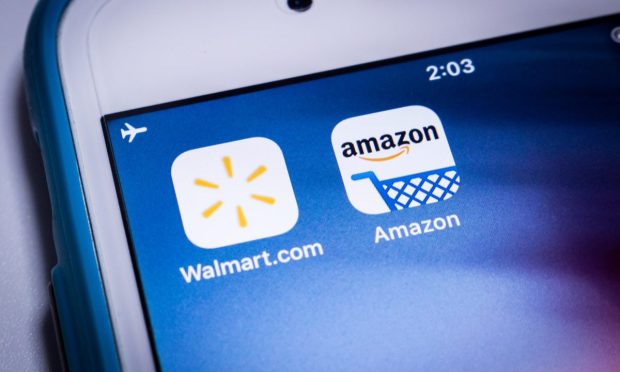AMZN vs WMT Weekly: Waiting on Earnings, Betting on Health

By this time next week, Walmart’s critical Q4 results will be in the books and fresh strategic plans will presumably be underway as to how it intends to keep customers engaged and coming back to its stores and website, rather than spending their money at rival Amazon or elsewhere.
One proven traffic and revenue-driver that both companies have embraced is healthcare.
As much as masks may be coming off, and the pandemic (knock on wood) appears to be in retreat once again, the shift and embrace of highly convenient telemedicine appointments is showing no signs of abating — as both patients and practitioners will continue to consult one another safely via video screen.
It’s a trend that Amazon, and many others, are not only betting will stay, but also represents a giant business opportunity to perfect and expand telemed’s usage and functionality.
To that point, the online retailing giant announced Tuesday (Feb. 8) that it is expanding Amazon Care telehealth service nationwide.
The program, which began at Amazon’s Seattle headquarters in 2019, will offer virtual-care visits, as well as free telehealth consultations and in-home visits for a fee from nurses for testing and vaccinations.
In addition, Amazon is adding in-person services in more than 20 cities this year.
The company said in a blog post that Amazon Care is uniquely positioned to fill a critical gap in the healthcare system because of the “wider range of care” that includes on-demand primary care and at-home chronic care management.
It is worth noting that rival Teladoc, which is focused on virtual doctor visits, saw its shares drop 6% when news of Amazon’s expansion into this category came out.
It’s a move that rival Walmart is also surely watching, as it continues to expand the list of services available at its own in-store pharmacies and vision centers, as well as through a budding string of stand-alone branded health centers. While the first Walmart Health center opened in Georgia in 2019, since then, additional locations have opened across the Southern U.S., in Arkansas and Florida. They offer primary and urgent care, labs, X-ray and diagnostics, counseling, dental, optical and hearing services.
To be sure, healthcare is an enormous category, but it is also a hugely competitive one filled with deep-pocketed, aggressive players like CVS, Walgreens, United Health Care and others, all of whom are moving forward with their own omnichannel versions of the clinic of tomorrow.
Grocery Woes and Wars
The food fight between Amazon and Walmart shifted overseas this week, after a recent decision by the U.K.-based Competition and Markets Authority to force the eCommerce giant to abide by the same rules and regulations as other supermarkets was seen as “chilling.”
The decision means that Amazon, whose U.K. sales amount to just $1.3 billion, will now be monitored by the Groceries Code Adjudicator to make sure it is treating its suppliers fairly.
Amazon said its Fresh & Wild subsidiary had only seven stores and that designating it as a grocery store would create a “chilling precedent.”
“We strive to build successful, long-term relationships with our suppliers and look forward to working with the Groceries Code Adjudicator,” an Amazon spokesperson told the Financial Times. “We are proud to work with thousands of suppliers and offer a great shop window for their products in the UK and around the world.”
As for its competition with Walmart, Amazon still has a ways to go.
Though Amazon has tried to break into grocery sales through its 2017 acquisition of Whole Foods and the opening of dozens of Amazon Go locations across the U.S., it has been unable to make very much of a dent. Amazon’s share of the food and beverage category has remained just below 2% since 2018, while Walmart’s share has remained steady at about 19%, according to PYMNTS proprietary data.
Tag, You’re It
Walmart announced on Wednesday (Feb. 9) that it is going to expand its use of radio-frequency identification (RFID) technology tags in its U.S. Division to improve inventory capabilities at its stores.
Walmart is adding the tags to dozens of types of merchandise after primarily using them on apparel, footwear, jewelry and tires. The company plans to add several more categories during the year.
Of course, the technology is used for more than making sure the shelves and racks are full. Macy’s said on Tuesday (Feb. 8) that it is using RFID tags to protect its assets as reports of high-profile retail thefts are increasing across the U.S.
When retailers use RFID tags on their merchandise, they can access real-time information on where and when products are being stolen, a Macy’s official told The Wall Street Journal. RFID tags can also help the company better target its security protocols, he said.
Looking Ahead
Two weeks after Amazon’s Q4 results and outlook and Walmart will be unveiling its earnings report bright and early (7 a.m. ET) on Thursday (Feb. 17), and investors will know how well the company actually did during the holiday season. Analysts are expecting a flat to slightly lower top line results but a bigger bump in earnings per share versus the previous year.
Some items of interest will include how well the company’s push in social media is going, including its deep embrace of live-streamed events. Also of interest will be updates on how Walmart — the self-titled low price leader — handled supply chain issues, as well as inflation and whether its size enabled it to take share away from rivals, and if home delivery via Walmart+ is expanding.
